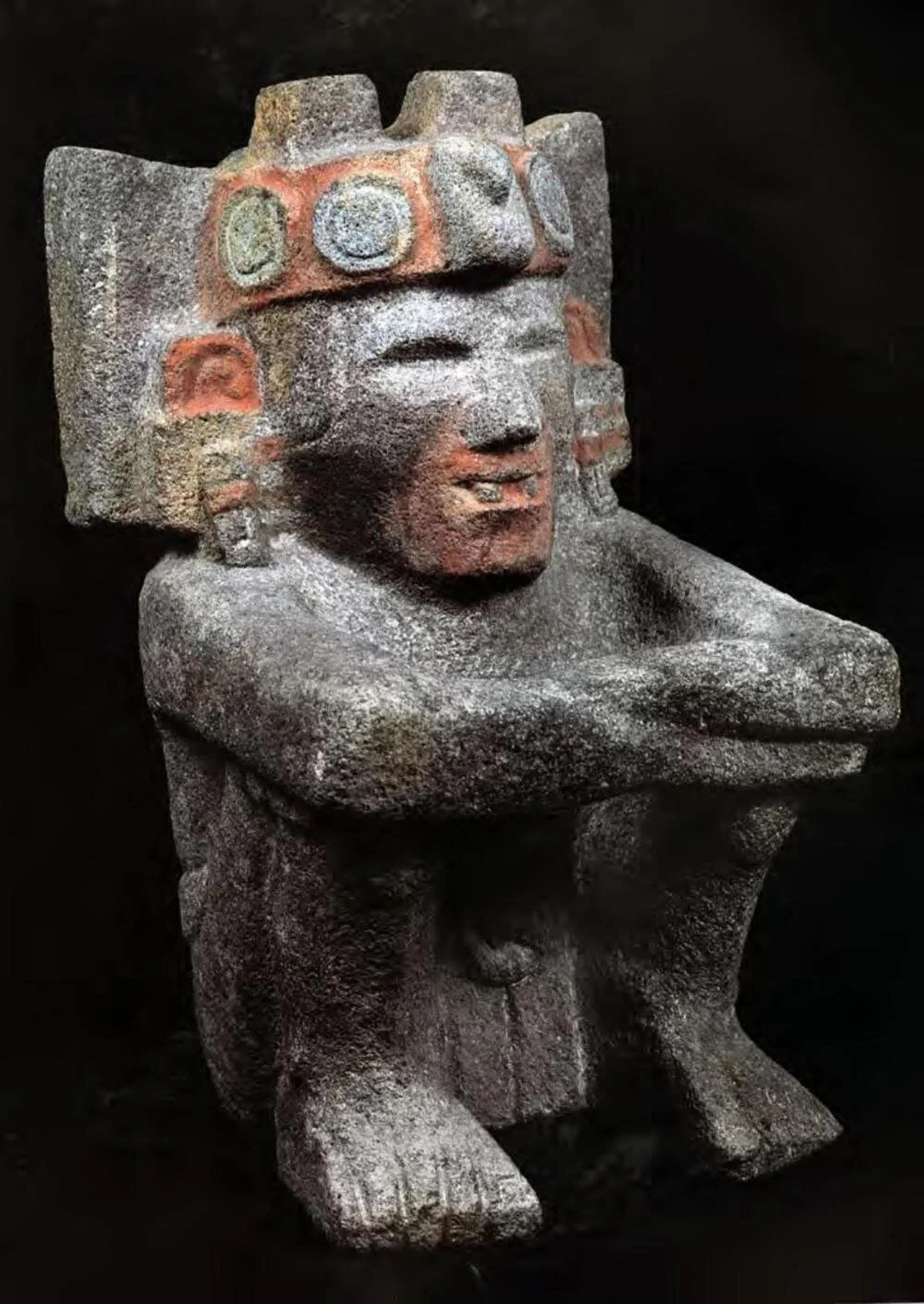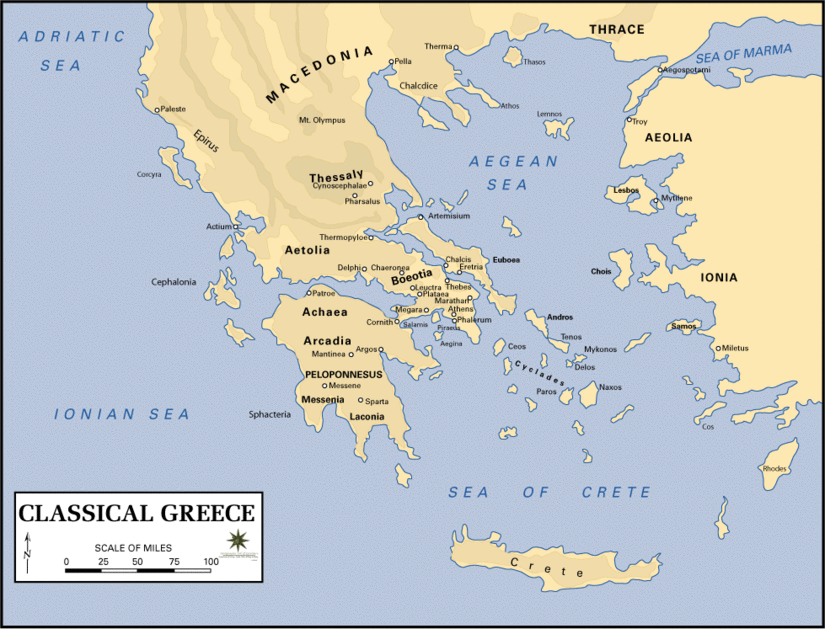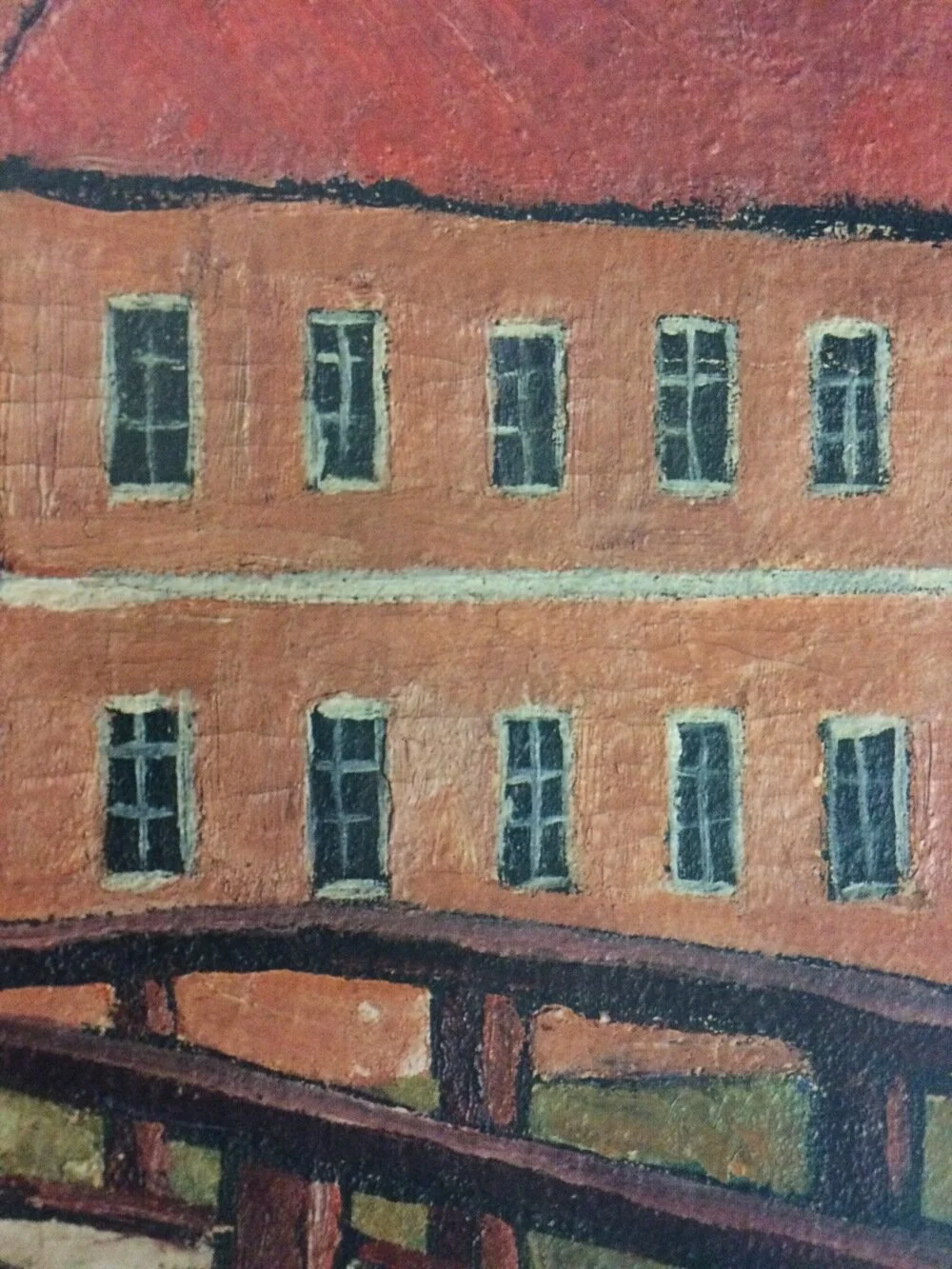THE TWO-HORNED GOD OF THE TEMPLO MAYOR
The earliest recorded excavations of images bearing the distinctive Two-Horned headdress were made in 1900 along Escalerillas Street (now known as Guatemala Street) in Mexico City. In excavations undertaken by the Mexican National Institute of Anthropology and History from 1978 to 1982, thirteen sculptures with the Two Horned headdress were found buried in the body of the Templo Mayor alone, and two were found within the Ceremonial Precinct. Generally deposited in small, stone-lined chambers, the sculpture was often accompanied by stone Tlaloc (rain god) vessels; flint knives; shells; animal remains; obsidian blades and polished miniature objects; greenstone beads, masks, and figurines; and other lapidary miniatures and deity insignia.
Although the Olmecs, the Maya, the inhabitants of Xochicalco, and the Tolecs were know to have buried stone monuments, these sculptures were generally mutilated or symbolically killed prior to interment. The phenomenon of the burial of a sculpture representing a specific diety emerges as a distinctively Mexica practice.
(left). Two-Horned God sculpture from Offering 1, Templo Mayor. After Garcia Cook 1978: 24. Figure 4 (right). Two-Horned God sculpture from Offering 11, Templo Mayor. After Association Francaise d'Action Artistique 1981: 66.
[The Mexia were a Nahua people who founded their two cities Tenochtitlan and Tlatelolco on raised islets in Lake Texcoco around AD 1200]
Generally measuring between 30 to 38 cm in height, the figure is seated with knees drawn up to chest and arms crossed over knees. His costume consists solely of a headdress, plain loincloth, and ear ornaments. Most distinctive is the headdress with its two rectangular "horns" projecting from the crown of the head; its headband decorated with circles flanking a central J-shaped curl over the forehead; its triangular-shaped slabs projecting from the nape of the neck; and its long rectangular panel hanging down the figure's back with two notched ovals resembling eggs or bow ties in high or low relief respectively. The ear ornaments are formed by a square with a long pendant from the center. Occasionally, facial paint has survived, primarily an oval of red surrounding the mouth and blue for the rest of the face. Two teeth protrude from beneath the upper lip at the corners of the mouth.
The salient characteristics of the Two-Horned God can be broken down into five categories: pose, headdress, ear ornament, teeth, and facial paint. (Since the only garment worn on the body is a simple loincloth, typical for Aztec males, this will not be considered as a distinctive trait.) Each of these five aspects of the sculpture will be considered to determine the identity of the figure.
POSE
The position of anthropomorphic sculpture often defined the gender of the image among the Aztecs. Certain poses were reserved for males and others for females. The seated posture of the Two-Horned God occurs in two variants. Most representations show the figure with knees drawn up to chest, arms crossed, and elbows resting on knees. In Aztec sculpture, this pose is typical for seated males.
HEADDRESS
The headdress of the Two-Horned God consists of four parts: (1) the two "horns," (2) the panel hanging down the figure's back, (3) the headband, and (4) the triangular attachments at the nape of the neck.
The significance of the turtle shell back device is perhaps more complex than a simple allusion to the earth. In addition to its relationship with the fructifying and creative powers of female fertility deities, it may have been an important symbol of sustenance, based on the reproductive means of the turtle itself. Sahagun described the mysterious birth of turtles as follows: "Thus does it bring forth its young: it lays its eggs on the sand; it buries them in the sand. In some way they go on to be hatched; they hatch. And when it is time to hatch, they are edible; they taste better than turkey eggs." He also says of the turtle, ". . . like the frog, it is edible, good-tasting, very good." The burial of the turtle's eggs and the subsequent birth of living, edible creatures forms a striking conceptual parallel with the act of the planting of agricultural sustenance, especially maize. This resemblance underscores the symbolic relationship between maize and turtles (maize being another figure often represented on the headdress).
In summary, it appears that two principal complexes are represented by the pose, headdress, ear ornaments, and teeth of the Two-Horned God. One relates to vegetation and fertility, and the other to supremacy and high status. The concepts of sustenance and vegetation are expressed by such insignia as tasseled corn or turtles in the headdress, pulque or rain god ear ornaments, and fertility or rain deity twisted-cord headband and fan-neck attachment. Exalted status is expressed by the jeweled headband. The two teeth and beard also express high status.
TWO-HORNED GOT AS TONACATECUHTLI
Tonacatecuhtli is not only the progenitor of humankind, but also the protector of his creation. On a human level, Tonacatecuhtli feeds the people by providing sustenance, especially maize. Tonacatecuhtli also provides divine sustenance, that is, human lives for sacrifice and autosacrifice, by sending babies to the earth. Tonacatecuhtli sustains the entire cosmos.
TONACATECUHTLI AND BURIAL PRACTICES
The act of burial had a multifaceted meaning for the Mexica that involved concepts of death, renewal, and protection. In mortuary contexts, burial was reserved for special groups of people. The way that a person died determined the treatment of the body and the ultimate destination of the soul. Most corpses were cremated and then buried. The only individuals who were buried directly in the earth were young children or babies; women who died in childbirth; warriors who died in battle; and individuals who died at the "hands" of Tlaloc by drowning, lightning, dropsy, or certain skin diseases. The corpses were often buried in special locations ? the symbolic "homes" of their respective supernaturals. Children, for example, were buried near granaries, sources of sustenance associated with the Lord of Sustenance, and women who died in childbirth were buried near the temple dedicated to their patron goddesses.
What is the significance of the act of burial to the Mexica? It appears that burial, as it does everywhere, operated on both a symbolic and a pragmatic level. Symbolically, burial was associated with the honored dead: those who died in particular sacrifices or under circumstances that indicated that they were "chosen" or "touched" by certain patron gods. At the same time, the act of burial was clearly linked symbolically with the world of the living and with survival in the form of agricultural, animal, and human reproduction and sustenance. In more practical terms, burial was a means of hiding hoarded valuables. Precious commodities were interred most frequently in the temple of a polity, the most sacred and thus the most tenaciously defended location and symbol for a political group. Although burial was one of many different ways of presenting an offering to the gods, it differed from other sacrifices, such as tossing an offering into a fire or into a body of water. Through burial an object was not destroyed, but rather was removed from circulation and hoarded in a specific immovable location. The burial of offerings in the Templo Mayor integrated the opposing meanings of burial - life and death - perhaps also channeling valued nonperishable commodities of the empire back into the empire. Furthermore, the permanent interment of precious and sacred objects in the Templo Mayor served to recharge the potency of the Templo Mayor as a powerful and effective political and ideological tool.
THE TEMPLO MAYOR
The Templo Mayor at Tenochtitlan, from 'Historia de Nueva Espana', 1770 (engraving)
Throughout time in Mesoamerica, structures significant for religious as well as political reasons were the primary locations for cache interment. Nevertheless, the quantity of offerings in general as well as of this specific type buried in the Templo Mayor is striking.
The capital of the Mexica Aztecs, Tenochtitlan, was a city constructed on an artificial island set in the marshy waters of Lake Texcoco. Although joined to the north to another, smaller island-city called Tlatelolco, both centers were essentially autonomous. Tenochtitlan, but not Tlatelolco, was divided into four quarters by four avenues that radiated out from the ceremonial precinct in the cardinal directions. The layout of Tenochtitlan mirrored the Aztec view of the horizontal organization of the cosmos, which was divided into five world directions with the Ceremonial Precinct as the central direction.
In the conceptual center of the Ceremonial Precinct was the principal temple of the empire, the Templo Mayor. This structure consisted of a low platform on which was elevated a tall pyramidal base with two stairways on the western side leading up to a pair of temples situated at the top. These twin temples were dedicated to a pair of opposing deities, Tlaloc (rain god) and Huitzilopochtli (god of war and the patron of the Mexica). These twin shrines have been considered a supreme place of duality, like Omeyocan, the highest of thirteen heavens where lived the gods of creation, Tonacatecuhtli and Tonacacihuatl or Ometeotl. The Templo Mayor was also considered an axis mundi, a place of passage between upper and lower realms. In fact, it has been suggested that the twin temples not only symbolized the highest of heavens, but also the pair of clashing hills in the netherworld that must be passed by the dead on their way to Mictlan, one of the Aztec places of afterlife.
The burial of Tonacatecuhtli in the Templo Mayor expressed symbolically the identification of the Templo Mayor and Tenochtitlan as center and as supreme place, just as Omeyocan, the place of duality, was the highest of all possible realms. It also identified the Templo Mayor with Tonacatepetl, the mythological Hill of Sustenance, paralleling Tenochtitlan's role as central redistributor for goods collected in tribute. The sacrifice and burial of Tonacatecuhtli was probably a petition for sustenance in the form of abundant maize. It implied that the Mexica were responsible for the continued supply of the maize that was essential for humankind. In cosmic terms, the sacrificial petition to the Lord of Creation and the interment of Tonacatecuhtli underscored the need for human births to feed the gods and singled out the Mexica as responsible for the continuation of the cosmos as a whole.
Much I have excerpted from various sources.
Please note that I do not own the copyright to most of the texts, images, or videos.





